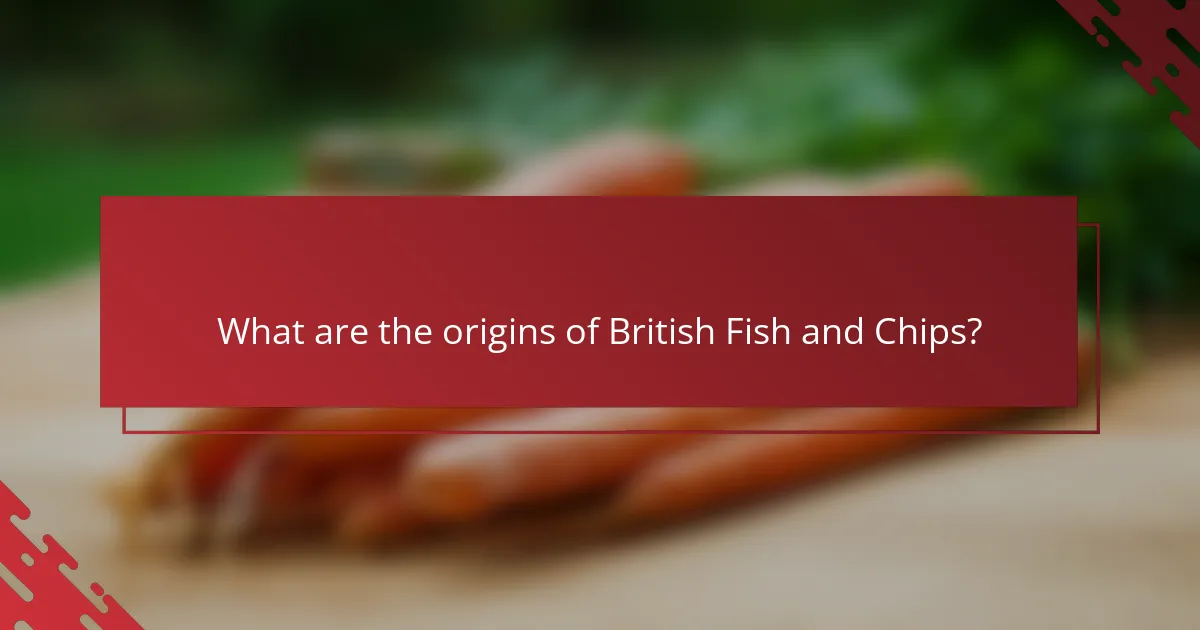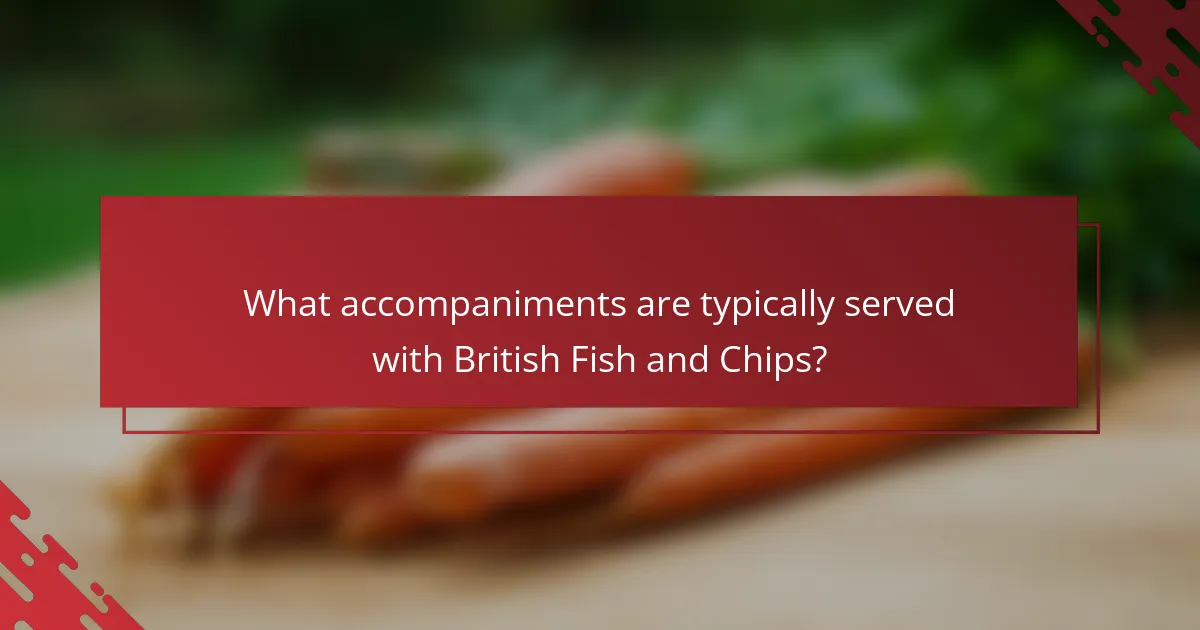British fish and chips is a traditional dish that originated in the United Kingdom during the 19th century, combining fried fish with deep-fried potatoes. The first recorded mention of this dish appeared in 1860 in London, where it quickly became a staple meal for the working class during the Industrial Revolution, influenced by Jewish immigrants’ fried fish recipes. Typical accompaniments include tartar sauce, mushy peas, and malt vinegar, which enhance the dish’s flavor profile. Regional variations across the UK showcase local ingredients and preferences, such as haggis in Scotland and curry sauce in London, reflecting diverse culinary traditions.

What are the origins of British Fish and Chips?
British fish and chips originated in the United Kingdom during the 19th century. The dish combines fried fish with deep-fried potatoes. The first recorded mention of fish and chips appeared in 1860 in London. The popularity of the dish grew due to the working-class diet. It became a staple meal during the Industrial Revolution. The combination was influenced by Jewish immigrants who brought fried fish recipes. The first fish and chip shop is believed to have opened in 1860 in London. This culinary tradition remains a beloved part of British culture today.
How did Fish and Chips become a staple in British cuisine?
Fish and chips became a staple in British cuisine due to their affordability and convenience. The dish gained popularity during the Industrial Revolution. Working-class families found it an easy meal option. Fish was often sourced from local waters, while potatoes were widely cultivated. The first fish and chip shop opened in London in 1860. This establishment helped popularize the dish across the country. By the early 20th century, fish and chips were firmly established in British culture. The meal became associated with national identity, especially during World War II when it was deemed a “national dish.”
What historical events contributed to the popularity of Fish and Chips?
The popularity of Fish and Chips in Britain was significantly influenced by several historical events. The introduction of deep frying in the 19th century allowed for the convenient cooking of fish and potatoes. The Industrial Revolution increased urbanization, leading to a demand for affordable, quick meals. The establishment of fish and chip shops began in the 1860s, making the dish widely accessible. During World War I, Fish and Chips became a staple for soldiers and the general public, reinforcing its popularity. The dish was also promoted as a national meal during World War II, as it was a cheap source of protein. These events collectively solidified Fish and Chips as a beloved British culinary tradition.
Who were the key figures in the establishment of Fish and Chips shops?
The key figures in the establishment of Fish and Chips shops include Joseph Malin and John Lees. Joseph Malin opened one of the first Fish and Chips shops in London in 1860. John Lees is credited with opening a Fish and Chips shop in 1863 in Mossley, Greater Manchester. Both figures played significant roles in popularizing this dish in Britain. Their establishments laid the groundwork for the widespread adoption of Fish and Chips as a staple meal. Malin’s shop was notable for its combination of fried fish and chips, which became a cultural icon. Lees’s shop is often cited as one of the earliest dedicated Fish and Chips shops in the UK.
What are the key components of British Fish and Chips?
The key components of British Fish and Chips are fish, chips, and batter. The fish is typically white fish, such as cod or haddock. Chips are thick-cut potatoes, fried until golden brown. The batter is made from flour, water, and sometimes beer, creating a crispy coating. This dish is traditionally served with malt vinegar or tartar sauce. The combination of these elements creates a classic British meal. Fish and chips originated in the UK in the 19th century and remain a popular takeaway option today.
What types of fish are commonly used in Fish and Chips?
Cod and haddock are the most commonly used fish in Fish and Chips. Cod is favored for its mild flavor and flaky texture. Haddock also has a similar taste profile but is often considered slightly sweeter. Both fish are traditionally battered and deep-fried. They are readily available in the UK, making them popular choices. The use of these fish dates back to the origins of the dish in the 19th century. Cod and haddock provide a classic taste that complements the crispy batter.
How is the batter prepared for Fish and Chips?
The batter for Fish and Chips is prepared using a mixture of flour, water, and sometimes beer. First, all-purpose flour is combined with cold water to create a smooth consistency. The batter should be thick enough to coat the fish evenly. Some recipes incorporate beer, which adds flavor and helps create a crisp texture. The mixture is then whisked until there are no lumps. This batter is typically chilled before use to enhance its crispiness during frying. The preparation of the batter is crucial for achieving the light and crunchy texture characteristic of traditional Fish and Chips.
What are the traditional cooking methods for Fish and Chips?
The traditional cooking methods for Fish and Chips include deep frying and baking. Deep frying is the most common method, where battered fish is submerged in hot oil until golden brown. This method ensures a crispy exterior while keeping the fish moist inside. The chips, or fries, are also typically deep-fried until they achieve a crunchy texture. Baking is less common but involves cooking the fish in an oven, often resulting in a healthier option. Historical records show that Fish and Chips became popular in Britain during the 19th century, solidifying deep frying as the preferred method.
How is Fish and Chips deep-fried to achieve the perfect texture?
Fish and Chips are deep-fried to achieve a crispy exterior and tender interior. The fish is typically coated in a batter made from flour, water, and sometimes beer. This batter creates a light, airy crust when fried. The oil temperature is crucial, usually maintained between 350°F to 375°F. Frying at this temperature ensures the batter cooks quickly, sealing moisture inside the fish. The frying process usually lasts around 4 to 6 minutes. This duration allows for even cooking without drying out the fish. Freshness of the fish also contributes to texture. Using firm white fish like cod or haddock enhances the overall experience.
What variations exist in frying techniques across different regions?
Frying techniques for fish and chips vary significantly across regions. In England, traditional frying uses beef dripping for a rich flavor. In Scotland, a popular method is deep-frying in batter, often using a light, crispy texture. The use of different oils, such as vegetable or sunflower oil, is common in various areas. In Wales, some establishments incorporate a unique seasoning blend into the batter. Northern Ireland often features a thicker batter for added crunch. Each region’s choice of frying temperature and time also influences the final texture of the fish and chips. These regional preferences reflect local tastes and culinary traditions.

What accompaniments are typically served with British Fish and Chips?
Typical accompaniments served with British Fish and Chips include tartar sauce, mushy peas, and vinegar. Tartar sauce is a creamy condiment made with mayonnaise, pickles, and herbs. Mushy peas are made from marrowfat peas, often seasoned with salt and pepper. Malt vinegar is commonly drizzled over the fish and chips for added flavor. Other accompaniments may include lemon wedges and curry sauce. These sides enhance the overall dining experience. The combination of flavors and textures is a hallmark of this traditional dish.
What are the classic sides that enhance the Fish and Chips experience?
Classic sides that enhance the Fish and Chips experience include mushy peas, tartar sauce, and pickled onions. Mushy peas provide a creamy texture and a slightly sweet flavor that complements the fish. Tartar sauce adds a tangy and rich element, enhancing the overall taste. Pickled onions offer a sharp contrast, balancing the dish with acidity. These sides are traditional accompaniments in British cuisine, often served in pubs and restaurants. They contribute to the authentic experience of enjoying Fish and Chips.
How does malt vinegar complement Fish and Chips?
Malt vinegar complements fish and chips by enhancing the dish’s flavor profile. Its acidity balances the richness of the fried fish and the starchiness of the chips. The tangy taste of malt vinegar cuts through the oiliness, providing a refreshing contrast. Traditionally, malt vinegar is used in British cuisine, making it a culturally significant accompaniment. This vinegar is made from fermented barley, contributing a unique taste that pairs well with the savory elements of the meal. Many diners enjoy sprinkling it directly on the fish and chips, which adds a zesty kick. The combination of flavors elevates the overall dining experience.
What role does tartar sauce play in the meal?
Tartar sauce serves as a condiment that enhances the flavor of fish and chips. It adds a creamy texture and a tangy taste, complementing the fried fish. Typically made with mayonnaise, pickles, and lemon juice, tartar sauce provides a contrast to the crispy batter. This condiment is especially popular in British cuisine. Its presence in a meal elevates the overall dining experience. The combination of flavors can balance the richness of the fried fish. Tartar sauce is a traditional accompaniment for fish and chips, reinforcing its cultural significance.
What beverages pair well with Fish and Chips?
Beer and cider are the most popular beverages that pair well with fish and chips. A light lager complements the dish’s crispy texture. A pale ale enhances the flavors of the fish. Traditional British ales, like bitter, also work well. Cider provides a refreshing contrast to the fried elements. Sparkling water can cleanse the palate effectively. Lemonade offers a sweet and tangy option that balances the dish. These pairings are favored for their ability to enhance the overall dining experience.
Why is beer a popular choice with Fish and Chips?
Beer is a popular choice with fish and chips due to its complementary flavors. The crispness of beer balances the richness of fried fish. Additionally, beer’s carbonation cuts through the oiliness of the dish. Many traditional recipes pair specific beers with fish and chips, enhancing the dining experience. Studies show that certain beer styles, like pale ales, enhance the taste of fried foods. This pairing has historical roots in British culture, where beer and fish and chips are often enjoyed together. The combination creates a satisfying meal that appeals to many.
What non-alcoholic options are suitable for pairing?
Sparkling water is a suitable non-alcoholic option for pairing with British fish and chips. It cleanses the palate and complements the dish’s flavors. Soft drinks like lemonade also pair well, providing a sweet contrast to the savory fish. Iced tea can enhance the meal with its refreshing qualities. Additionally, non-alcoholic beers offer a similar taste profile to traditional beer, making them a popular choice. Fruit juices, especially tart varieties like cranberry, can balance the richness of the dish. These options enhance the dining experience without the effects of alcohol.

What are the regional variations of Fish and Chips in the UK?
Regional variations of Fish and Chips in the UK include distinct styles and ingredients. In Scotland, haggis is often served alongside fish and chips. In Wales, you may find the dish accompanied by mushy peas and a specific type of batter. The North East features a unique variation called “parmo,” which includes a breadcrumbed chicken or pork fillet topped with béchamel sauce. In the South, particularly in London, fish and chips may be served with a side of curry sauce. Each region showcases local preferences, influencing the choice of fish, such as cod or haddock, and the type of batter used. These variations reflect local traditions and culinary influences across the UK.
How do different regions in the UK prepare Fish and Chips uniquely?
Different regions in the UK prepare Fish and Chips with unique techniques and ingredients. In London, fish is often fried in a light batter made from beer, giving it a distinct flavor. In the North East, the use of a thicker batter is common, sometimes even incorporating breadcrumbs for extra crunch. Scotland is known for “haggis-stuffed” fish, where the fish is filled with haggis before frying. In Wales, fish and chips are frequently served with curry sauce, adding a spicy twist. The South Coast tends to use fresh local fish, such as plaice or sole, emphasizing freshness. Each region’s approach reflects local tastes and available ingredients, showcasing the diversity of this classic dish.
What distinguishes London-style Fish and Chips from those in the North?
London-style Fish and Chips are characterized by a lighter batter and often use cod or haddock. In contrast, Northern styles typically feature a thicker batter and may include fish like plaice. The frying technique in London often results in a crispier texture. Northern fish and chips are sometimes served with mushy peas, while London versions may include tartar sauce. The portion sizes can also differ, with Northern servings often being larger. Additionally, the use of beef dripping for frying is more common in the North, whereas London may use vegetable oil. These distinctions reflect regional preferences and traditions in preparation.
What are the unique ingredients or methods used in Scotland?
Unique ingredients used in Scotland include haggis, neeps, and tatties. Haggis is a traditional dish made from sheep’s offal and spices. Neeps refers to mashed turnips, while tatties are mashed potatoes. These ingredients often accompany fish and chips in Scotland. The cooking method includes using batter made from locally sourced beer, enhancing flavor. Scottish fish and chips may also feature a unique deep-frying technique, often in beef dripping for added richness. These elements create a distinct variation of fish and chips that reflects Scottish culinary heritage.
What are some modern twists on traditional Fish and Chips?
Modern twists on traditional Fish and Chips include various innovative ingredients and cooking techniques. One popular variation uses tempura batter instead of the classic beer batter. This results in a lighter, crispier texture. Another twist features alternative proteins, such as salmon or tofu, catering to diverse dietary preferences. Additionally, some restaurants serve fish and chips with unique sauces like sriracha mayo or curry sauce.
Sweet potato fries have also gained popularity as a substitute for traditional chips, offering a different flavor profile. Furthermore, gourmet versions often incorporate artisanal fish and house-made chips. These adaptations reflect current culinary trends while maintaining the essence of the classic dish.
How are contemporary chefs reinventing Fish and Chips?
Contemporary chefs are reinventing fish and chips by incorporating innovative ingredients and cooking techniques. They experiment with different types of fish, such as cod, haddock, and even sustainable options like pollock. Chefs are also using alternative batters, including gluten-free and tempura styles, to appeal to diverse dietary needs.
Additionally, modern accompaniments like homemade tartar sauce, pickled vegetables, and gourmet fries are being introduced. Some chefs are pairing fish and chips with international flavors, such as curry or spicy aioli. This evolution reflects a growing emphasis on sustainability and creativity in traditional British cuisine.
The combination of these elements showcases a shift towards a more contemporary and personalized dining experience.
What fusion cuisines incorporate Fish and Chips elements?
Fusion cuisines that incorporate Fish and Chips elements include British-Indian and British-Japanese cuisines. British-Indian cuisine often features fish curry served with crispy fried fish, resembling traditional Fish and Chips. British-Japanese cuisine may present tempura fish with chips, blending techniques and flavors. These adaptations highlight the versatility of Fish and Chips in various culinary contexts.
What tips can enhance the preparation of Fish and Chips at home?
To enhance the preparation of Fish and Chips at home, use fresh fish for better flavor. Cod and haddock are popular choices due to their flaky texture. Ensure the batter is cold before frying; this creates a crispier coating. Use a mix of flour and cornstarch for a lighter batter. Fry the fish at a temperature of 350°F to 375°F for optimal cooking. Maintain the oil temperature to prevent sogginess. Serve with homemade tartar sauce for added taste. Pair with thick-cut chips for a traditional experience.
British fish and chips is a traditional dish originating in the United Kingdom during the 19th century, characterized by deep-fried fish, typically cod or haddock, served with thick-cut fried potatoes. The article explores the historical context of fish and chips, detailing its rise as a staple meal during the Industrial Revolution and its establishment as a national dish during World War II. It also examines key components, traditional cooking methods, regional variations, and popular accompaniments, such as tartar sauce and malt vinegar, while highlighting modern adaptations and tips for home preparation.